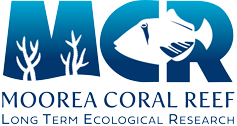Year:
2022
Authors:
Source:
M.S. Thesis
Abstract:
Coral reefs worldwide have been affected by a suite of ongoing disturbances that have led to the destruction of stony coral colonies and the formation of expansive benthic cover of rubble. Community recovery of those degraded reefs is in part determined by the success of scleractinian re-colonization and the longevity of those colonies. Yet, in rubble dominated portions of the reef, re-colonization success may be modulated by the physical features and dynamics of the postmorality legacies of stony corals and antecedent carbonate matrix. This thesis develops a regional comparison between rubble dominated reefs in St. John, United States Virgin Islands and Moorea, French Polynesia, to investigate sessile reef taxa and the pieces of rubble on which they settle, with marked differences between the sites due to departures in rubble size, rubble material composition and local hydrodynamic energy. In Chapter 2, ecological surveys, an in situ growth experiment, and lab-based incubations of rubble tested how the physical environment of rubble beds in the back reef of Moorea, French Polynesia at ~1–2 m depth, affects the abundance and physiology of scleractinians that recruit to this habitat. Psammocora spp. corals were the most abundant coral found on rubble (~70% of all corals; average length of rubble ~11 cm), while Porites spp. were the most commonly found coral on pavement and bommies (~40% of all corals) at sites closer (30 m) and farther (130 m) from the reef crest. Lowered growth rates of juvenile colonies of both Psammocora profundacella and Porites spp. in rubble beds did not explain the success of P. profundacella in rubble habitats. Further, the proximity of rubble to the reef crest did not affect measurements of rubble community rates of primary productivity or calcification. In Chapter 3, a mensurative study in St. John, US Virgin Islands examined fringing reefs at ~8 m depth that have extensive areas of carbonate and igneous rubble produced by hurricanes, erosion, and island geomorphology. The capacity for important Caribbean reef taxa, such as scleractinians (< 4 cm in diameter) and octocorals (< 10 cm in height), to utilize rubble surfaces following Hurricanes Irma and Maria in 2017 was influenced by the size and weight per volume of the rubble on which they were settled. Rubble ranging from 5–100 cm in diameter were populated by 15 genera of scleractinians, of which ~60% were Porites spp., and 11 genera of octocorals of which 30% were Eunicea spp. Overall, these results from studies in St. John and Moorea demonstrate that populations of small colonies of scleractinians and octocorals are modulated by physical dynamics generated within rubble-dominated reefs. The size and material density of rubble influences the capacity for hydrodynamically-driven movement and level of consolidation, which alters the potential for ecologically important reef taxa to occupy space in physically disturbed environments.
Publication Type:
Thesis or Dissertation
Publisher:
Department of Biology, CSU Northridge



